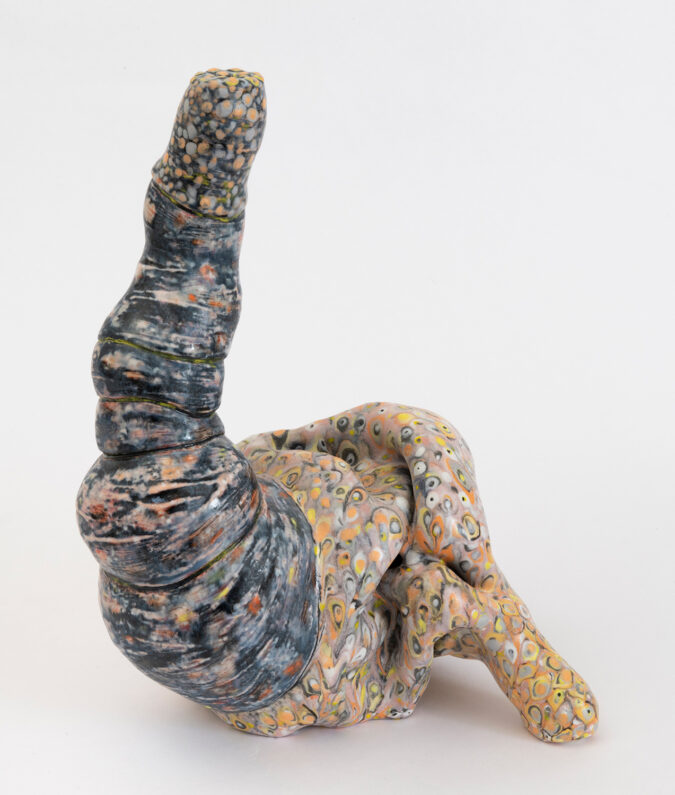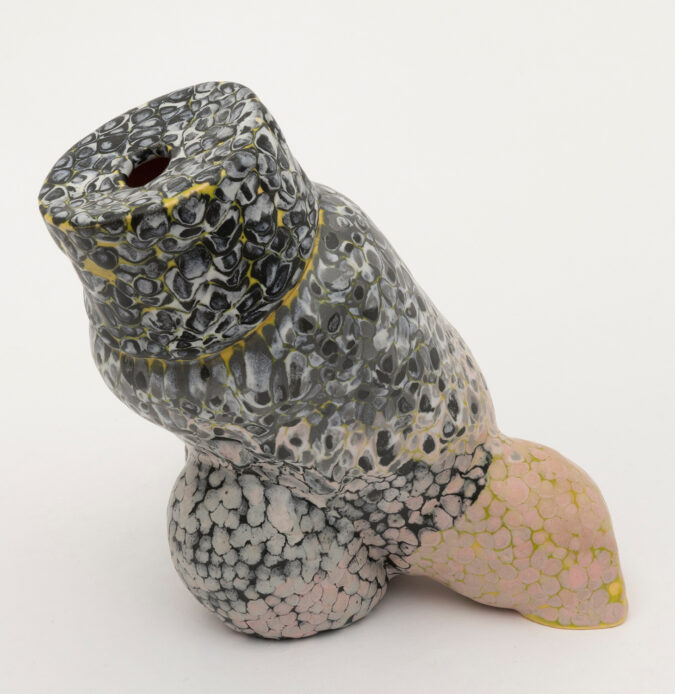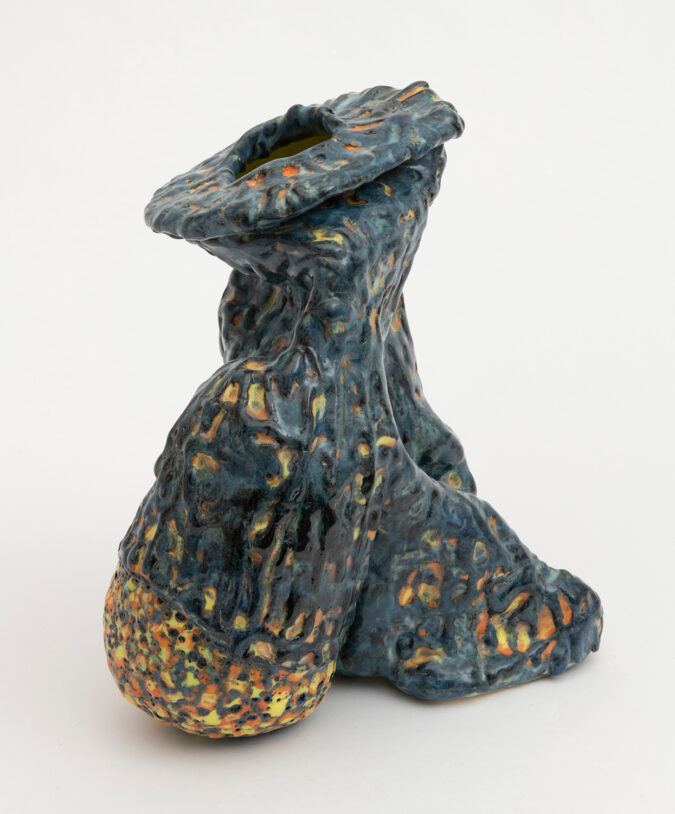Elisa D’Arrigo
Elisa D’Arrigo was born and raised in The Bronx, NY, receiving a BFA in ceramics from SUNY New Paltz in 1975. She has worked with a range of materials, focusing on hand-stitched cloth pieces for over 15 years. In 2010 she began working in ceramics again.
D’Arrigo has had 21 solo exhibitions including at the High Museum of Art, David Bietzel Gallery, Luise Ross Gallery and Lehman College Art Gallery; her 11th solo at the Elizabeth Harris Gallery, “Materializing” of recent ceramics, just ended. Her work is included in “Shapes From Out of Nowhere: Ceramics From The Collection Of Robert A. Ellison Jr.”, currently on view at the Metropolitan Museum of Art, NY.
Her works are in the collections of The Metropolitan Museum of Art, The Everson Museum, The Mead Art Museum, The High Museum of Art, The Samuel Dorsky Museum of Art, The Mint Museum of Art and Design, and The Weatherspoon Art Museum. She was a recipient of a NYFA in drawing, and enjoyed fellowships at the Civitella Ranieri Foundation, Yaddo, and The MacDowell Colony.
She lives and works in New York City.
Question
The physical forms of your sculpture look like they are created in one session spontaneously. While there are twists, bends and folds in the form, they, for the most part, appear to be a singular complete shape. If they are made from parts, the elements merge into a unified form. In contrast, it is clear that the surface is created through the accretion of multiple repetitions. It is possible for your 3D modeling and 3D color application are different modes of working. Ultimately in a finished piece the 2 processes cohere. Do you like alternating between 2 modes of work? Do you return to one of them when tired with the other?
Answer
Daniel, thank you for the pleasure and honor of this exchange with you, for your close looking and thoughtful question.
Actually, the two processes cohere somewhat from the beginning. Your observation that the works appear as a unified form is something I tend to do, and they are indeed made from several parts that are merged, as you mentioned. I almost always make the works using an array of basic forms, hand-built from slabs rolled out with a rolling pin. I avoid any labor-saving devices like extruders or slab rollers. For one thing, I need the exercise, but I also gravitate towards the irregularity of the handmade.
I begin with open cylinders, and from those create spherical, tubular, and rectilinear elements, usually working with about 5 or 6 forms of varying sizes and shapes. I play with these forms, combining, cutting into them, recombining; all the while seeking a configuration that speaks to me, feels fresh and not fully known. Seams, edges and how the form sits, reclines, stands or even slouches all get a lot of attention. The vase is my muse with these works; they usually hold water and require at least one orifice. That orifice, and the fact that ceramics generally need to be hollow, conjures a figural presence. I consider the works’ configurations to be poses in a way. They are taking a stance or are in a paused position between moves. I feel their position in my own body, and those positions often record or express my own transitory states of mind. Clay is a good material for revealing the previously unthought. The playing around process involves an inner dialogue that is not necessarily articulated verbally in my mind. There is musing, and a bit of a dream state when things go well. The emerging forms develop identities, proclivities and telling details: a fold or bend might imply the inner crease of a bent arm, a jutting elbow, or an abdominal roll. Using cylinders and other elemental forms to make these pieces recalls those “how to draw the figure” exercises which employ the tactic of breaking down the figure into basic forms, which I did spend time with as a young person self-teaching.
Alternating between forming works and dealing with glazing is a necessary part of the process – and are done in tandem as well. I alternate as needed – it is not about preference or getting tired of one over the other. As soon as I begin putting a form together, I’m thinking about surface and color and how they will affect that form – the two are inseparable and each affects the other. A form’s appearance can alter depending upon what is happening with surface, color, and how that color is layered, transitioned, and applied.
Developing the surface and coloration begins while a piece is still wet; this is done with underglazes, and stained porcelain slips (slip is clay in a liquid form) as a preliminary layer. I’m trying to hedge my bets by having something promising to work with when the piece comes out of the first firing – the bisque firing. Similar to how a blank piece of drawing paper is intimidating, so is a bare bisqued piece. I like having something to react to. I rarely begin glazing a piece that does not already have some color and surface handling. Because of the pandemic, and reduced access to a kiln, I am even more involved with pre glazing and have taken to brushing on the porcelain slip – whereas I used to stay away from brushes, using things like eye droppers or sticks, I now also deploy cheap coarse bristled brushes that leave an imprint of the strokes in the wet slip. Like a kind of fingerprint.
The life of working on a piece is like a mini-drama – sometimes it is a wunderkind: there was an easy birth, it came together almost on its own, and after only one glaze firing is fully realized and ready to exist. Others make tedious trips back and forth to the kiln…either for complete makeovers or just subtle tweaks. Every firing holds promise, and one remains hopeful. Sometimes after several firings, things work out beyond expectations, and I think of the piece as a late bloomer. Other times not at all, and additional re-works are attempted. I try not to give up on anything, but there can be sad endings. I might realize after several tries that the form is really not in fact so interesting and truly not worth any more time. As if it had a failure to thrive. Or more rarely, a piece I considered a failure and had relegated to the lost cause shelf gets a last-ditch attempt that actually works.
I am reglazing a few works right now that I made in early 2020 and had given up on. I’m hoping to be pleasantly surprised. I don’t have the luxury of choosing which mode of work to engage with – the piece leads the way, and I try to do what is needed as its humble servant. It is hard for me to start something new with clay when there is an unresolved glazed piece to tend to. So, to somewhat answer your question, the actual working with clay is the biggest rush and the most exciting mode, but the glazing is a way to slow down and fine tune the piece’s personality.









Fascinating and enlightening description of how your works develop. “The vase is my muse” conveys the starting point of each piece, but seems to have a second meaning in that as a kind of body (or womb?) itself, it brings forth the particular body that develops into that sculpture. I love the sense of your engagement with how you form the works, as well as how you follow the works as they become themselves — the luck that is a part of making art, be it good and bad. And the time it takes to know whether which it is.
Great question and wonderful thinking through the response! I can feel the work coming to life through the description of the process.
Beautiful pieces-I love the shapes, the colors and the textures
very handsome
I think I like seeing your work photographically as much as I like seeing it in person.
Somehow the photographs reveal elements you don’t see when looking at the pieces themselves.
Great presentation of your work and ideas!